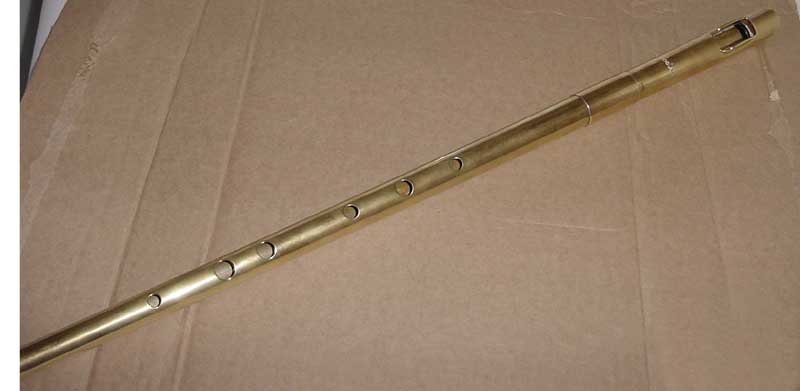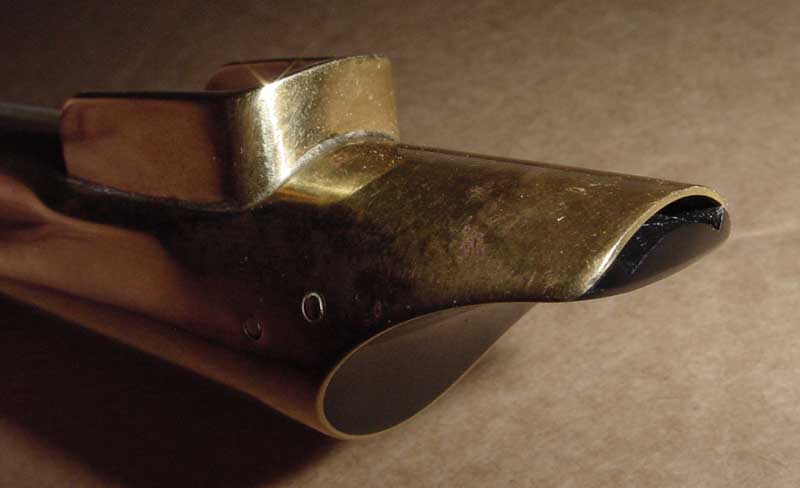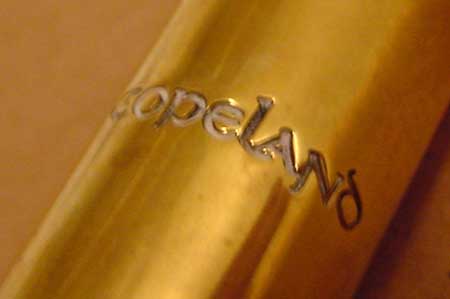Copeland Brass Low D whistle Review
(Review written March 2005)
- Preface
-
Back in 1999 or so, I had a Brass copeland low D. I even recorded a few tunes on my website with it: Down by the Sally Gardens, Star of the County Down, & Twisting of the Hayrope.
But it really was too much whistle for me at the time. In 2001, when I was out of work and struggling to make ends meet, it was sold, since I was able to reclaim a lot of the money I'd spent on it. Part of the motivating factor was that I really wasn't comfortable with it's breath requirements yet, either. Dale Wisely, of Chiff and Fipple advised me to reconsider. Others theorized that I'd come to regret the decision. And I did.
So, when I recently saw the opportunity to get another Copeland low D for what I'd sold the original for, I jumped at the chance. It helped that I'd just gotten my yearly bonus from work. Someone tried to snipe my bid at the last minute on Ebay, but I won at exactly the price I was hoping to get the whistle at. When it arrived, I wasn't disappointed.
- At a Glance
- Whistle Reviewed
- Copeland Brass Low D whistle
- Models Available
- many keys and materials. Low D's come in brass and silver, and in 2 or 3 piece designs.
- How Acquired
- Shrewd bidding on Ebay.
- Construction
- Brass, with delrin fipple.
- Price at Time of Review (in US Dollars unless otherwise noted)
- $475.00
- Available From
-
Ebay (Note that Michael has since closed up shop. He occasionally puts up whistles on ebay)
- Appearance
- The instrument is world class. The brass is rich and golden, and the instrument has very sleek lines. The Copeland is a conical bore instrument--I have read that the conical bore helps the instrument stay in tune with itself across the octaves. The Copeland low whistle also has a very unique wall around the windway/labium ramp area. There's no question that this is a professional instrument.
-

Here it is. I usually polish up my brass Copelands with BrassO or other polishing agent. I haven't done that to this one yet, but I did rub it a little bit with a polishing cloth about a week before these pictures were taken, so there's still a light patina of tarnish on sections of it. Even so, this is a nice looking instrument.
Here's a closeup of the mouthpiece. You can see the wall around the windway area, and the delrin mouthpiece (secured by two pins on each side). You can't really see it, but the windway is curved, and not straight. According to Dale Wisely's interview with Michael Copeland, the wall strengens the notes, especially the low ones.
And the logo, on the mouthpiece. I saw that it had some polish residue (left from it's previous owner) so I got out some water, toothpicks, and Q-Tips and cleaned it right up. I knew Q-Tips were bound to be good for something since the doc told me you're not supposed to stick them in your ear.
A picture of only the bottom three holes of the whistle. I took this one to help show how far away the last note is from the rest of the pack. I do talk about this more later in the hole size section.
- Playing Characteristics
- I think Dale once called the Copeland low D "buttery" in tone. It's definitely a good description, even if it only means something once you play the whistle. The Copeland low D has a rich tone to it that is really flute-like; it has a subtle reediness that is unlike the scratchiness of Generation or Feadog whistles, being very mellow and smooth. It's kind of jazzy, in a way. It's hard to describe, there really is no comparison between the Copeland low D and any other low whistle I've ever played. I think my newer one is a little less rich and jazzy and a little easier to blow than the old one, which had a strong jazzy character.
-
Sound clips of the whistle:
The Black Cat,
O'Gallagher's FrolicsVolume: This whistle is on the medium-loud side for low whistles. I make that distinction, because I haven't yet met a low whistle that is as loud as the loudest high whistles I've played. I took this one to the rowdy Friday session I go to, and it didn't cut through like a high D Copeland but it did blend in with the other instruments well. I wouldn't have tried to start a tune with it in that environment, though..it wouldn't be heard clearly enough. The Cheiftain low D (new range) is a touch louder, and the Alba low D is louder still.
Responsiveness: This whistle is highly responsive. It'll pretty much take everything I can throw at it. As is true of mellower-sounding instruments, the ornaments aren't bright and chipper sounding, but they don't get so mellow they completely wash out.
Tuning: This whistle is in tune when warmed up. You don't have to play the lower-scale notes (DEF) significantly softer than the higher ones. The wall definitely serves it's purpose here. I can't push the rest of the whistle around nearly as much as the C-Natural, but I was able to get about a +-15 to 20 cent range, which still allows for a fair amount of expression.
C-natural: OXXOOO produces a c-natural that's right on the money. Sticks to the center of the tuner and just stays there with the expected breath control. That said, you can really push that around. I able to blow it 57 cents flat and 42 cents sharp with breath control. That's a lot of control!
Hole size and placement: Folks with small hands may have some trouble with the Copeland Low D. The bottom hole is way off in Never-Never Land away from the next hole up. I play fingertip style and have a huge reach from thumb-tip to pinkie-tip (nearly 10") so I don't have any issues myself. But I have come to realize that I'm somewhat of a freak of nature that way. That said, the bottom hole is small enough in diameter that if you choose to use your pinkie there (as I do) it's no problem to cover.
Air volume and pressure requirements: This whistle doesn't have much back pressure, and has air requirements on the medium-high side. This was a problem for me 4 years ago, when all of my other whistles had much lower air requirements. It's not a problem for me now..but since I owned this whistle last, I got used to the breath requirements of the Silkstone Alloy and the Copeland high D, both of which take more breath than your average cheapie. If you're used to cheapies or Burkes, this one will definitely take some getting used to. I suspect that this one is slightly easier to blow than my first one, at the cost of some of the richness of tone.
I'm not sure where to sing kudos about this instrument's chiff, so I'll do it here, since it's highly dependant on your breath. This instrument is pretty pure as far as start-of-note chiff goes, though if you attack it a bit, you can make the Copeland produce this really awesome flute-like chiff. It's really nice!
Clogging: Moderately wet. This whistle would get wet after extended playing--especially if a little cold--but didn't really clog up on me. I was able to blow a fair amount of moisture out after playing for a while, so it's definitely something you'd want to tend to over the course of an evening.
Wind Resistance: I know the walls around the ramp are supposed to help strengthen the bottom notes..but I also can't help but think they help with wind, also. The Copeland low D moderately resists crosswinds, making it pretty good to play outdoors unless it's just really blowing out there.
- Summary
- Awesome instrument, but I wouldn't really recommend it for beginners. But once you are able to master the breath requirements, it's an instrument without compare. Truly the king of the low D whistles, as far as I'm concerned.